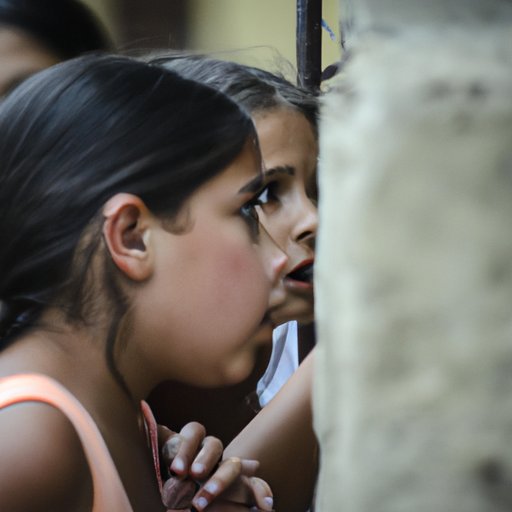I. Introduction
Child immigration is a complex and pressing issue that affects countless families around the world. The documentary “Which Way Home,” directed by Rebecca Cammisa, provides a heartbreaking yet informative glimpse into the realities of child migration, specifically highlighting the journey of several children from Central America to the United States. The film provides important insights into the challenges faced by these children and their families, shedding light on a topic that is often overlooked or misunderstood.
The purpose of this article is to explore the themes and messages presented in “Which Way Home” and to provide a broader context for understanding child immigration. This article is intended for anyone interested in social justice issues, immigration policy, or documentary filmmaking.
II. Synopsis of “Which Way Home”
“Which Way Home” follows the journeys of several children from Guatemala, Honduras, and Mexico, as they attempt to cross the treacherous border between their home countries and the United States. The film captures the physical, emotional, and mental toll that this journey takes on the children, their families, and the communities they leave behind.
One of the most prominent characters in the film is Kevin, a 14-year-old boy from Honduras who is embarking on the journey alongside his younger brother. The audience gets a glimpse into Kevin’s life before he leaves, including his struggles with poverty and his fears about leaving his family behind. The film also features other children, ranging in age from 9 to 17, each with their own unique stories and motivations for leaving their home country.
The themes explored in the documentary are varied but include the reasons behind child migration, the difficulties faced by child migrants, and the emotional and psychological impact of the journey. Some of the most emotional scenes in the film include the moment when Kevin and his brother say goodbye to their mother, the children discussing their fears and frustrations at a shelter in Mexico, and the devastating moment when one of the children is separated from his family.
III. The Realities of Child Immigration
Child immigration is a complex issue that is affected by a range of factors, including poverty, violence, and social instability in countries of origin. For many children, the decision to leave their home countries is not an easy one, often made out of desperation for a better life or to support their families financially.
The journey itself is often dangerous and difficult, with children being exposed to violence, exploitation, and high-risk situations. The emotional and psychological toll of the journey can also have long-lasting effects on a child’s mental health and well-being. Additionally, the physical challenges of the journey, including traveling long distances on foot, can result in serious health issues or even death.
IV. The Importance of Documentary Filmmaking
Documentary filmmaking plays an important role in raising awareness about pressing social issues and influencing policy. Visual storytelling can be a powerful tool for conveying complex issues to an audience and sparking conversations around important topics such as child immigration.
Documentaries like “Which Way Home” can also be valuable for their ability to provide a platform for marginalized voices and to bring attention to underreported issues. Through their use of interviews, archival footage, and creative storytelling techniques, filmmakers can shine a light on important issues that might not otherwise be given the attention they deserve.
V. The Role of Guilt in Immigration
Guilt can be a factor in the decision-making process for many immigrants, particularly children who feel responsible for supporting their families financially. The experience of leaving one’s home country can be a traumatic one, marked by feelings of fear, loss, and guilt. For children, this experience can be especially devastating, as they are often forced to mature quickly and take on responsibilities that are far beyond their years.
When discussing the issue of immigration, it’s important to be mindful of the emotional and psychological effects that traumatic experiences can have on individuals. Empathy and understanding are crucial in creating a more compassionate and just society, one that recognizes the challenges faced by those who are forced to leave their homes and seek a new life elsewhere.
VI. The Legacy of “Which Way Home”
Since its release in 2009, “Which Way Home” has had a significant impact on public discourse around child migration and immigration policy. The film has been praised for its honest and compassionate portrayal of the realities faced by child migrants and their families, and it has helped to shift the public conversation around these issues.
The film has also contributed to ongoing activism and advocacy efforts, including discussions around immigration reform and the need for greater support for families affected by migration. As a result, “Which Way Home” has become an important tool for those seeking to address the complex issues surrounding child migration and immigration policy.
VII. Conclusion
“Which Way Home” is a powerful and emotionally charged documentary that provides important insights into the realities of child immigration. Through its use of visual storytelling and evocative imagery, the film is able to convey the challenges faced by child migrants and their families with compassion and empathy.
This article has explored the themes and messages presented in “Which Way Home” and has provided a broader context for understanding child immigration and the role of documentary filmmaking in shaping public understanding and policy. By raising awareness about the challenges faced by child migrants, we can help to create a more just and compassionate society for all.
